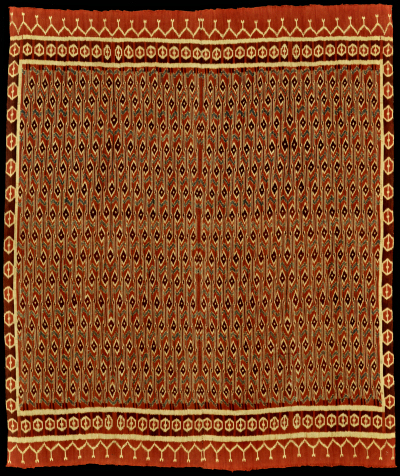| |
066 Sulawesi, Toraja
Seko mandi (shroud)  
|
| Locale: | Galumpang district. |
| Period: | 1970s |
| Yarn: | Cotton, hand-spun, medium; loosely twined 2-ply warp, twin weft. |
| Technique: | Warp ikat |
| Panels: | 2 |
| Size: | 149 x 181 cm (4' 10" x 5' 11") LW: 1.21 |
| Weight: | 950 g (33.5 oz), 352 g/m2 (1.15 oz/ft2) |
| Design: | The meaning of the shimmery, psychedelic, pattern with its disturbed order is not certain. It is said by some authors to represent highly stylised human figures, but may also represent bamboo shoots. Whatever its meaning, the pattern vibrates with tension and seems irrepressibly alive. |
| Comment: | Toraja ikat from the 'revival' period, but of uncommonly high quality. Khan Majlis: 'Tiny offsets in the positioning of the rows of diamonds, diagonal connecting lines and alternation between light and dark fill the sequence of simple ornaments with tension and life.' [Size yet to be entered.] |
| Background: | Chapters on Sulawesi and Toraja. |
| Exhibited: | Museu do Oriente, Lisbon, 2014/15. |
| Published: | Woven Languages, 2014. |
| Compare: | 067 |
| Sources: | Near-identical cloth in British Museum, AN331708001. Nearly identical to midfield of cloth from Galumpang in Khan-Majlis, Woven Messages, Fig. 396. Similar to seko mandi in Textile Museum of Canada, ref. nr. T77.0107. Pattern shows curious similarity to Iban pua in Serawak Museum with pucuk (puchok) rebong, bamboo shoots pattern. |
| |

©Peter ten Hoopen, 2025
All rights reserved.
|


